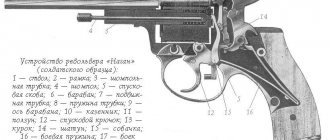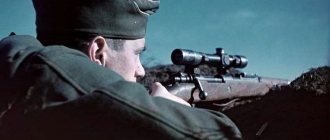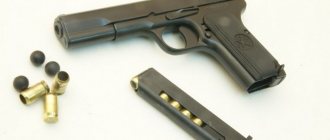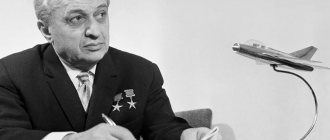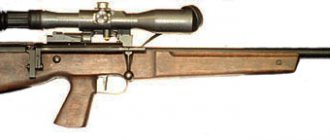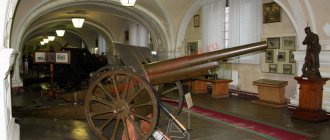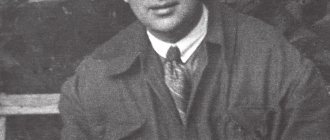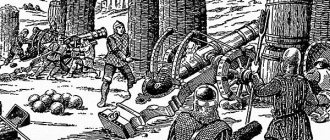Russia has launched production of a civilian version of the Nagan revolver. A civilian rifled carbine will be made on the basis of original historical samples - Nagan revolvers from different years of production. The weapon will have a long barrel and a wooden butt, which makes it comply with Russian weapons legislation (the length of the weapon is more than 800 millimeters). The historical prototype of the new-old revolver was the elongated version of the Nagant of the border guards of the Tsarist Army, produced at the very beginning of the 20th century.
Winner by death
The Nagan system revolver of the 1895 model (GRAU index - 56-N-121) is a seven-shot revolver developed and produced by Belgian industrialists brothers Emil and Leon Nagan for the Russian Empire, which was in service and produced in a number of countries in the late 19th - mid-20th centuries. . Let us recall the history of its adoption.
Nagan system revolver. Infographics Read more
Before the advent of smokeless powder, the Russian army had the first and only standard Smith-Wesson revolver in service. The huge 10.67 mm caliber model was designed for black powder. The “American”, which was put into service in 1871, clearly required replacement. Then the Russian military department finally announced a competition for a new revolver.
The Russian military department put forward very strict requirements for the new army revolver: caliber 3 lines (7.62 mm), simplicity and reliability of design, high penetrating power of the cartridge. Interestingly, the military demanded a reduction in the rate of fire, abandoning self-cocking firing, and in addition to this, abandoning the automatic extraction of spent cartridges. Probably, the military was very afraid of the high consumption of ammunition - economy was paramount.
The favorites in the competition were two Belgian gunsmiths - Leon Nagant with his already quite famous in the world revolver of the 1878 model, which underwent two modernizations in 1886 and 1892, and Henri Pieper with the Bayard revolver.
Bayard lost due to its higher difficulty. Although there is an opinion that Nagan won thanks to connections that Leon personally had in Russia, his revolver really was more suitable for the stated requirements.
Launched into production in 1895, the revolver quickly began to enter the army. “Nagan” became one of the symbols of the Russian Revolution of 1917 and the subsequent civil war, and later the word “Nagant” became a common noun - in colloquial speech this was often the name for any revolver.
Nagan also performed well during the Russo-Japanese War. Comfortable and unpretentious, he gained respect among officers and soldiers. Then, in the First World War, in brutal trench battles, the revolver was distinguished by its reliability; it was not scary to drop it in sand or mud, or shoot in the rain or dust.
Only after the end of World War II the revolver was removed from service. The reason was primarily the unsatisfactory reloading speed. Nevertheless, revolvers served in the police until the end of the 60s, and with collectors and special communications until the 80s.
Originally from Liege. How the Nagant revolver became a Russian legend Read more
"Nagan" - a revolver, a rifle and... a car!
Classic of the genre: “Comrade Sukhov” with a revolver in his hand... Still from “White Sun of the Desert”
“With Lenin in his head and a revolver in his hand.”
(“Good” V. Mayakovsky) Weapons and companies.
This material had been promised for a long time, but somehow never got around to it. And not because there was little information. The most pressing question arose not of searching for it, but of selecting it. Because this weapon and this company turned out to be very popular, in all respects. However, it is better to read late than never read. In any case, the beginning will be traditional: and it so happened that two brothers, Emile (1830–1902) and Leon (1833–1900) Nagant, founded a company in the Belgian city of Liege in 1859: Fabrique d'Armes Emile et Léon Nagant, Quai de l'Ourthe (Emile and Leon Naganov's Arms Factory, Ourthe Embankment).
A meeting with the Remington brothers in 1867 allowed them to license the production of 5,000 Remington rifles for the Vatican's Papal Guard. By improving the locking system, they created guns known as the Remington Nagant, whose bolts opened and locked slightly differently than the classic Remingtons.
Stamp with keys on the barrel of a Remington-Nagant rifle
Remington-Nagant rifle. Length 114 cm, barrel length 71 cm. Caliber .44
The bolt control lever of the Reminton-Nagant rifle, combined with the trigger guard
Diagram of the bolt mechanism of the Remington-Nagant rifle from patent No. 63999 dated January 30, 1884. It clearly shows the action of the trigger, as well as the hinged bolt, controlled by the trigger guard-lever.
The brothers then contributed to the development of the Dutch Mle 1873 revolver, which was produced by the Hembrugh Arsenal and the Beaumont company in Maastricht. Then, in 1876, a rifle of 11 mm caliber of the Eustachios Mylonas system was produced for Greece, and in 1877 they created a double-barreled pistol of 9.4 mm caliber (a cartridge produced by the Belgian company Bachmann, known as 9.4 Nagant or 9.4 Belgian) with a Remington bolt . The Belgian Gendarmerie used them until 1901, and it turned out to be the first Belgian regulatory weapon chambered for a metal cartridge.
The bolt of the Milonas rifle, controlled by a lever under the receiver
Double-barreled pistol for the Belgian gendarmerie with a Remington bolt
The same pistol in the version with a butt
Finally, it came to revolvers. In 1878, the Nagans created the “Nagant” model, available in both single and double action versions, which spawned a whole “stream” of revolvers adopted by a wide variety of European countries:
in Belgium - models of revolvers 1878, 1883 and 1878/86. caliber 9.4 mm; in Norway - model 1883 double action; in Sweden - model 1887 caliber 7.5 mm; model 1893, 7.5 mm caliber, went into service with the armies of Norway, Serbia and Sweden; caliber .44 (11 mm) - in Brazil and Argentina.
"Nagan" 1878 Royal Arsenal, Leeds
And finally, the 1895 model (“without gas loss,” as the creators themselves called it) with 7.62 caliber was adopted for service in Russia.
"Nagan" 1895 "Russian model"
In 1887, the Nagants were working on a 7.65 and 8 mm caliber rifle, which turned out to be too complex.
This is the rifle they offered to the military of several countries. As you can see, it was made on the basis of the Mannlicher rifle and with his magazine, but it was distinguished by an original bolt with a rear loading handle. In this, the Nagan brothers were ahead of all other weapon designers!
The bolt and reloading handle of the rifle of Emil and Leon Naganov. Interestingly, it was initially charged from below, for which the lid of its magazine was folded forward! Weight 3.895 kg (4.325 with bayonet). Cartridge: 8 mm welt. Length without bayonet: 1,220 m. Barrel: length 68.5 cm – 6 grooves from right to left
This was followed by the famous rivalry with Captain Mosin in Russia, which resulted in the "unnamed" rifle of 1891, adopted by the Russian Imperial Army in place of the Berdan rifle.
In 1896, the brothers divided their enterprise. Emile Nagant, suffering from blindness, left the company, and Leon immediately created the Fabrique d'Armes Leon Nagant and, together with his two sons Charles (1863) and Maurice (1866), went on a car tour in 1899. After Leon's death in 1900, the company became known as Fabrique d'Armes et d'Automobiles Nagant Freres.
"Nagan" 1878 nickel plated
"Nagan" 1878 disassembled and cartridges for it
Well, what was the “revolver” of 1878 and why was it popular? This is a self-cocking revolver, intended for the Belgian army and produced by the Naganov company in Liege, and then there, but at the state-owned Manufacture of Arms on Rue Saint-Léonard.
All the main parts of the revolver were made of Bessemer steel. English cast steel was used for all springs, screws, rods, hammer, trigger and safety hinges. German hardened steel was also used. The degree of interchangeability of parts is high. The barrel is octagonal, except for its rear part. The Model 1878 drum has six chambers. It is charged through the right side door (“Abadi Door”), which folds vertically along the trigger guard.
"Abadi Door" Revolver "Nagant" M1887, .22 caliber
This is how it works...
The Russian revolver of the 1895 model had the official name “Three-line revolver (7.62 mm) model of 1895.” and was produced by the Tula Arms Factory since 1900. It differed from all others in the presence of a drum for seven rounds, which moved onto the barrel, which eliminated the breakthrough of gases in the area of contact between the barrel and the drum. There were single and double action revolvers (officer model).
Revolver M1884 of the Luxembourg Gendarmerie. Right view
Revolver M1884 of the Luxembourg Gendarmerie. Left view
Revolver M1884 of the Luxembourg gendarmerie, disassembled
Nagan supplied 20,000 revolvers to Russia before production began in Tula in 1899, many of which survived until the end of World War II.
The story of the adoption of this revolver for service is even more complicated than the story with the rifle. There was a competition, all the conditions of which seemed to be specially tailored to the performance characteristics of the Naganov revolver. And it would be strange if he didn’t win under these conditions!
"Nagan" of the Luxembourg gendarmerie, equipped with... a bayonet!
By 1895, the Russian military began to express dissatisfaction with Smith and Wesson revolvers. Yes, they hunted bison and bears with them, they withstood 10,000 shots without problems and quickly reloaded, but... they were too “heavy to wear.” The belt with the holster slipped to the side, and for some reason they didn’t think of shoulder straps back then. As a result, it was decided that the revolver was rarely used, and therefore there was no point in carrying 1.5 kg of alloy steel on its side. That we need a lighter and more convenient revolver, capable of solving the problem with seven shots, against the enemy’s six!
Shortened Nagan, released in the USSR in 1925
And this is his marking...
And in disassembled form...
This is where the “revolver” came in handy. In addition, it was psychologically not so ... “frightening”, since it did not give a powerful flash of flame behind the drum directly behind the trigger guard. The blunt-nosed bullet had a good stopping effect, and for some reason the fact that it took a long time to load the revolver did not bother anyone. Although, in essence, this turned the new revolver into a disposable weapon. But... it turned out that everything came together on this revolver: weight, price, ease of maintenance, accuracy and destructive power, and on top of everything else, the already accumulated experience in using such weapons, which, in fact, turned from combat to status.
"Nagan" M1895, manufactured in the USSR in 1938.
"Nagan" M1895, manufactured in the USSR in 1941.
"Nagan" M1895, manufactured in the USSR in 1945.
The production of the “Russian” revolver, which dates back to 1898, was started in Belgium at the Leon Nagant Arms Factory. Civil production of the new revolver began even before the registration of the Russian order.
The Russian contract guns produced in Liege were double action, but the manual supplied with each revolver explained which parts needed to be replaced to convert the double action into a single action! Also in 1898, the revolver was patented.
The revolver was successfully sold on the civilian market. But in 1910 it was improved. Now the revolver has a drum that tilts to the right, also for seven rounds. The Russian Imperial Army no longer purchased this improved model.
"Nagant" M1910
“Nagant” M1910. Looks like an “Abadi door.” But not the door. Drum lock
"Nagant" M1910 with the drum folded back
Such a “revolver” was also produced - hammerless, or rather, had a hidden trigger. Self-cocking only
Serbian and Soviet "Nagans" 1938
Swedish M1887 revolver of 7.5 mm caliber and a holster for it...
The most surprising thing is that the company then began producing cars. And not our own, but under a French license. Nagant cars were produced from 1900 to 1928. The company was then purchased in 1931. This is where the story ends, but the story of the “revolvers” themselves is by no means over...
Car manufactured in 1909. Type “D” 14/16 l/s.
Lowman Museum, The Netherlands P.S.
The author and administration of the site express their gratitude to Alain Daubresse for the opportunity to use his photographs. To be continued…
For hunting and collection
The civilian version of the Nagan revolver will be pistols stored in warehouses, which will simply be converted into carbines. According to the manufacturers, the new weapon may be of interest to both collectors and military history buffs, as well as hunters. Apparently, therefore, it is planned to release both the product in the original caliber 7.62 by 38 millimeters, and a hunting version in caliber 22 (small-caliber rimfire cartridge - 5.6 millimeters).
Interestingly, a similar story happened 10 years ago. In 2011, the Izhmash enterprise presented a new small-caliber revolver carbine, created according to the design design of the legendary Nagan revolver. The carbine was equipped with two types of cartridges: 22LR and 22WMR. Both types of cartridges are members of the 5.6 mm rimfire family and are used in civilian weapons.
And in 2022, a Russian private company presented a hunting carbine based on the 1985 Nagan revolver, codenamed “Shadow-7.” The carbine looked like a Nagant revolver with a long barrel and a FAB Defense Glock stock type stock attached to it in the area of the handle. The revolver is chambered for the 5.45×18 mm cartridge. According to experts, the Shadow-7 carbine resembled a weapon from a post-apocalyptic game like Fallout.
A source of information:
https://tass.ru/ekonomika/12677837?utm_source=yxnews&utm_medium=desktop&utm_referrer=https%3A%2F%2Fyandex.ru%2Fnews%2Fsearch%3Ftext%3D
